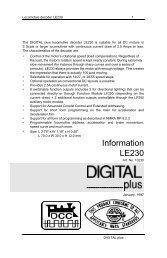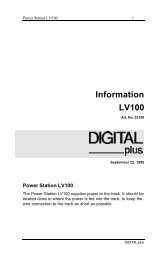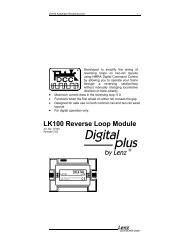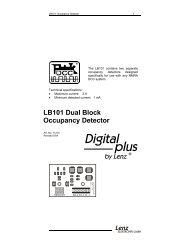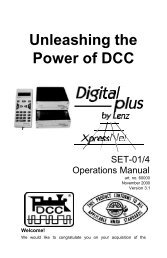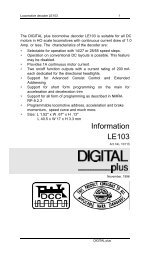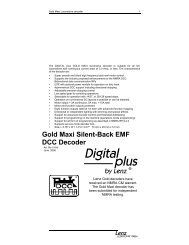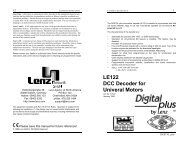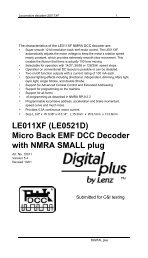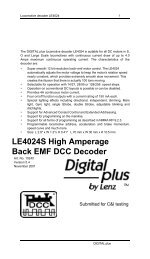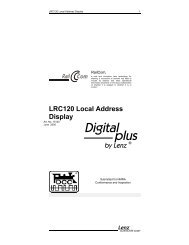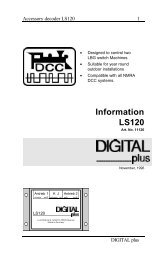LE1025-JST (LE130XF) Back EMF DCC Decoder - Lenz USA
LE1025-JST (LE130XF) Back EMF DCC Decoder - Lenz USA
LE1025-JST (LE130XF) Back EMF DCC Decoder - Lenz USA
- No tags were found...
You also want an ePaper? Increase the reach of your titles
YUMPU automatically turns print PDFs into web optimized ePapers that Google loves.
Locomotive decoder <strong>LE1025</strong> 1The DIGITAL plus locomotive decoder <strong>LE1025</strong> is suitable for all DC motors inHO scale locomotives with continuous current draw of 1.0 Amp. or less. Thecharacteristics of the decoder are:Super smooth 12 bit resolution back-emf motor control. The <strong>LE1025</strong>automatically adjusts the motor voltage to keep the motor’s rotation speednearly constant, which provides extremely smooth slow movement. Thiscreates the illusion that there is actually 100 tons moving.Selectable for operation with 14/27, 28/55 or 128/256 speed steps.Operation on conventional DC layouts is possible or can be disabled.Provides 1A continuous motor current.Four function outputs, one rated at 500 mA and three rated at 150 mA each.Special lighting effects including directional, independent, adjustable dimming,Mars light, Gyro light, single Strobe, double Strobe, adjustable blinking andditchlights.Support for Advanced Consist Control and Extended AddressingSupport for programming on the mainlineSupport for all forms of programming as described in NMRA RP-9.2.3Programmable locomotive address, acceleration and brake momentum,speed curve and much more.Size: L 0.88" x W 0.62"x H 0.25" L 22.5mm x W 16mm x H 6.3mm<strong>LE1025</strong>-<strong>JST</strong> (<strong>LE130XF</strong>)<strong>Back</strong> <strong>EMF</strong> <strong>DCC</strong> <strong>Decoder</strong>Art. No. 10136Version 5.4January 2002
Locomotive decoder <strong>LE1025</strong> 2The features of the <strong>LE1025</strong> <strong>Decoder</strong>The <strong>LE1025</strong> has been revised and is packed with features youexpect in a high end decoder. Advanced consist control, extendedaddressing, outstanding 28 step motor control, and 4 functionoutputs (two for directional headlight control) are but a fewexamples. The <strong>LE1025</strong> supports all forms of programmingdescribed in NMRA Recommended Practice 9.2.3, including theuser friendly direct CV programming mode. Also, standard is abuilt in self-test procedure. The advantages of this standardizationare obvious: Every locomotive decoder responds in the same wayto changes in their properties. All new DIGITAL plus locomotivedecoders are produced according to these NMRA <strong>DCC</strong> standards.This standardization will greatly improve interoperability oflocomotive decoders for all manufacturers.DIGITAL plus decoders built to the NMRA standards andrecommended practices are labeled:This prestigious label means that the NMRA has tested thisproduct and found that it fully complies with all NMRA <strong>DCC</strong>Standards, Recommended Practices and industry norms. The<strong>LE1025</strong> decoder was tested by the NMRA's C&I committee andhas been awarded an NMRA Warrant.Many characteristics of the <strong>LE1025</strong> decoder can be programmedto customize the decoder to its locomotive. For example, you canoperate the decoder with the factory pre-set speed table orgenerate your own. You can set which end of the locomotive is theforward end. You can even decide whether or not you want to beable to operate on conventional DC layouts.Please read “Programming the <strong>LE1025</strong> locomotive decoder” foundlater in this booklet for details on the configuration variablessupported by the <strong>LE1025</strong>. There you will find much moreinformation regarding the features and their respective settings.2
Locomotive decoder <strong>LE1025</strong> 3<strong>Back</strong> <strong>EMF</strong> ControlThe <strong>LE1025</strong> uses a form of motor control called "back emf"control. All DC motors produce a small amount of current whenthey are rotating. The amount of current produced is a function ofthe load that the motor is controlling. The <strong>LE1025</strong> measures thiscurrent and is able to adjust the current to the motor based uponthe motor load. The result is exceptionally fine motor control thatis extremely smooth and quiet.The <strong>LE1025</strong> employs the finest motor control possible. It issuitable for all forms of motors including coreless motors.Preparing to Install the <strong>LE1025</strong>A locomotive that runs well under DC will run exceptionally wellunder <strong>DCC</strong>. Replace worn out motor brushes and burned out lightbulbs. Clean any dirt or oxidation from the wheels and pickups,and make sure that electrical contact is good. Remove anysuppression capacitors connected to the motor brushes as theywill prevent the back emf from functioning properly. Now is also agood time to lubricate your locomotive.An internal rectifier supplies the current for all the decoder outputswith a maximum current rating of 1.0 Amps. The sum of thecurrent to the motor and the function outputs cannot exceed thislimit. Each individual output can only draw up to its limit.Example:Suppose the motor may require as much as 0.8 A continuously.Then the function outputs combined must not exceed 0.2 A. If thedirectional headlights require 50 mA each, then the load onoutputs C and D must not exceed 150 mA.Some advice on installing the decoder:Although the <strong>LE1025</strong> has many internal safeguards to preventdamage, you must not allow any metal part of the locomotive totouch the surface components of the decoder. This could cause adirect internal short circuit and the decoder will be destroyed. Themotor brushes MUST also be completely isolated from the railpickup. Achieving isolation may require some differentapproaches on different locomotives, perhaps unsoldering wires,placing a thin piece of insulating plastic between the brush
Locomotive decoder <strong>LE1025</strong> 4terminal and contact spring. If you have a VOM, check for infiniteresistance between the motor and all the wheels. Take specialnote that metal contact might occur only when the loco body isreinstalled.DO NOT WRAP decoder with electrical tape or shrink wrap!Doing so will impede air circulation and degrade the performanceof the decoder. Instead, put electrician tape over any part of thelocomotive frame or body that might touch the decoder and usedouble sided foam mounting tape to mount the decoder. This willprevent short circuits without 'suffocating' the decoder.The <strong>LE1025</strong> can not be set up for simultaneous use for 2-railpickup and overhead cantenary or trolley operation. If thelocomotive is turned the wrong way, the decoder could get twicethe track voltage, which would destroy it!Wiring OptionsThere are two wiring options for installing the <strong>LE1025</strong>, dependingon how the locomotive is constructed. The functions could beconnected with their common to the decoders floating common(blue wire) as shown below or one rail can be used as a common.A mixture of both options is also possible.OrangeMotorGrauGreyRotRedSchwarzBlackWeißWhiteGelbYellowGrünGreenViolettPurpleFA B C DFBlauBlueIf the bulbs for the directional headlights are floating (isolatedagainst wheel pick up and chassis) and connected according toabove figure, they will shine brighter compared to using the rail asa common and the directional headlights will function whileoperating on conventional DC layouts.4
Locomotive decoder <strong>LE1025</strong> 5Step by Step InstallationIf the locomotive has a NMRA <strong>JST</strong> decoder socket simply removethe dummy plug and plug in the decoder. The followinginstructions apply if you need to install one of the various available<strong>JST</strong> harnesses.Two wires connect the decoder to the motor. Make sure that themotor is electrically isolated from both track pickups:Orange wire to the motor terminal that waspreviously connected to the right rail (Pin #1).Gray wire to the motor terminal that waspreviously connected to the left rail (Pin #5).Two wires connect the decoder to the track electrical pickups:Red wire to right rail pickup (Pin #8).Black wire to the left rail pickup (Pin #4).Five wires connect the headlights and functions to the decoder:White wire (Pin #6) to the forward headlight or the functioncontrolled by Output A. If the bulb is isolated, connect the bluewire (Pin #7) to the other terminal.Yellow wire (Pin #2) to the rear headlight or the functioncontrolled by Output B. If the bulb or function is isolated, thenconnect the blue wire (Pin #7) to the other terminal.Green wire (Pin #3) to function controlled by Output C. If thebulb is isolated, connect the blue wire (Pin #7) to the otherterminal. Output C is rated for 500mA.Violet wire to function controlled by Output D. If the bulb isisolated, connect the blue wire (Pin #7) to the other terminal.Place the locomotive (without its shell) on the programming trackand read back the locomotive's address from the decoder. If thedecoder is properly installed, you will be able to read back thefactory pre-set address 03. Remove the locomotive from thetrack, and if necessary correct any wiring errors.
Locomotive decoder <strong>LE1025</strong> 6Programming the locomotive decoder <strong>LE1025</strong>The <strong>LE1025</strong> supports all NMRA <strong>DCC</strong> programming modes andcan be programmed by any NMRA <strong>DCC</strong> programmer. With someentry level systems only a few CVs (such as CV #1, thelocomotive address) can be set unless you use a separateprogrammer. Specific details for reading and writing the decoder’sconfiguration variables can be found in the manuals of theappropriate equipment used for programming.The configuration variables and their meaningThe following table lists the various CVs supported in the <strong>LE1025</strong>decoder. Both the NMRA <strong>DCC</strong> CV numbers and the olderRegister numbers are provided for cross reference.Please note: Some CVs (such as CV29) have specific meaningsfor each bit. The bit assignments in this table use a bit numberingscheme of 0-7 to correspond the NMRA convention for universalbit numbering. Many handhelds (such as the DIGITAL plus LH100handheld) use a scheme of 1-8 to refer to the individual bits ratherthan 0-7. (Bit 0 in this table is displayed as a"1" on LH100handheld, Bit 1 is identified as "2".) The bit numbers in () withinthese tables contain the LH100 bit numbers.Table 1: <strong>LE1025</strong> Configuration VariablesCV Reg Description Range Factorysetting1 1 Locomotive address:This is the number with which you select alocomotive in the DIGITAL plus system.Setting the address from #1 to #3 using registermode will reset the decoder to utilize 14 speedstep operation.1-127 32 2 Start voltage:This is the voltage applied to the motor in speedstep 1. Set this value so that the locomotive juststarts moving in speed step 1.3 3 Acceleration Momentum:Determines the rate of change of speed uponacceleration. A higher value leads to a sloweracceleration.**Note: in the factory setting field the numbers in the [ ] are decimal.1-15 01-31 16
Locomotive decoder <strong>LE1025</strong> 7CV R Description Range Setting4 4 Brake Momentum:Determines the rate of change of speed uponbraking. A higher value leads to longer brakedistance.1-31 15 - Maximum speedDetermines the maximum speed that the locomotivewill move. This allows you to operate yourlocomotives in a prototypical speed range.(only active if back emf enabled)1-10 10- 5 Contains CV29 (see CV29 below) 0-55 6- 6 Page/Pointer Register:Normally this CV is not modified directly by a user.For correct operation, this CV should be set to havea value of 1 after any use.7 7 Version Number:This location stores the version number of thedecoder. This location is read only.8 8 Manufacturers Identification:Contains the manufacturer ID of the decoder,(<strong>Lenz</strong> =99). Writing a value of 33 using Register moderesets all CVs to their factory condition9 - <strong>EMF</strong> FrequencyAdjusts the pulse rate frequency for finer motorcontrol. This value also effects the minimum speed.0-127 1- 54- 990-15 1017 - Extended Address High Byte 192-231 018 - Extended Address Low ByteThe two byte address if used is contained inCV17+1819 - Consist AddressThe advanced consist address if used is stored inCV1929 5 <strong>Decoder</strong> Configuration, Byte 1:Several decoder properties are set with this byte.Changes are best done in binary mode (see theinformation for the Hand Held LH100). The detailedproperties are:bit 0(1)Locomotive direction:Locomotive’s relative direction: This bit setsthe direction the locomotive will move whentold to move forward in digital mode.0 = locomotive’s direction is normal1 = locomotive’s direction is reversed0-255 00-255 00-63 60,1 0[1]
Locomotive decoder <strong>LE1025</strong> 8CV Description Range Settingbit 1(2)Headlight mode:0 = Operation with 14 or 27 speed step systems.This setting is selected when the locomotivedecoder is used with any Digital system that doesnot support 28 speed step mode. If the headlightsturn on and off as the speed is increased, thecommand station is configured for 28 speed stepmode, and the decoder is in 14 speed step mode.1 = Operation with 28, 55 or 128 speed steps. If youuse this setting, the Command Station must also beconfigured to use 28 speed step mode or 128 speedstep mode for the decoder's address, otherwise theheadlights can not be controlled.0,1 1[2]bit 2(3)Usage on conventional DC layouts:0 = locomotive operates in digital mode only0,1 1[4]1 = locomotive can operate on either conventionalDC and on <strong>DCC</strong>bit 3 (4) Enable RailCom 0,1 0 [8]bit 4(5)bit 5(6)Speed Curve Selection:0 = factory pre-set speed curve is used1 = user defined speed curve is used using thevalues in CV 67 to CV 94Extended Addressing0= Normal addressing1= Four digit extended addressing0,1 0[16]0-1 0[32]bit 6 bit 7 always 0 0 050 <strong>Decoder</strong> Configuration, byte 2:Similar to CV 29, but other properties are set with this byte:0-7 1bit 0(1)<strong>Back</strong> <strong>EMF</strong> ControlIf set back emf control is activebit 1 not usedbit 2 Brake momentum on DC operation.(3) Used to achieve prototypical braking at red signalindications if conventional DC control CV29.2 isdisabled. (CV 29 bit 2 = 0)0 = locomotive proceeds with track voltagedependent speed inside the conventional DCsection.1 = locomotive brakes in the conventional DCsection with pre set brake momentum.bits 3-7 not used0,1 1[1]0,1 0[4]8
Locomotive decoder <strong>LE1025</strong> 9CV Description Range Setting51 Lighting Special Effects for Outputs A 0-255 0bit 0(1)bit 1(2)0 = the headlights (A&B) are directional.1 = the lights (A&B) are independent per Rule17. F0 controls the front headlight and F1 therear headlight or a separate function.Only active if dimming (bit 2 (3)) is set to a valueof 1. The value in CV52 is used for dimming.0 = function A output is always dimmed1 = If directional F1 is used for dimming, ifindependent F4 is used for dimming0,1 0[1]0,1 0[2]bit 2 (3) Output A can be dimmed 0,1 0 [4]Bits 3-7 are only active for independent lighting. If more than one bit is set, only thehigher bit is active. If a bit is set dimming is inactive.bit 3(4) Not used 0,1 0 [8]bit 4 (5) Output A is a Gyrolight 0 [16]bit 5 (6) Output A is a Mars light 0 [32]bit 6 (7) Output A is a Single Strobe 0 [64]bit 7 (8) Output A is a Double Strobe 0 [128]52 Dimming CV for Output A - contains the value used fordimming. 0 is dark 255 is max brightness0-255 6453 Lighting Special Effects for Outputs C and D 0-7 0bit 0 (1)bit 1 (2)bit 2(3)1 = Output C blinks with the frequency set inCV561 = Output D blinks with the frequency set inCV561= Outputs C and D act as Ditch Lights. CV55controls which function turns on both ditch lightsand CV54 controls which function activates thealternating blinking.0,1 0 [1]0,1 0 [2]0,1 0[4]54 Function assignment for Output C 0-255 1bit 0 (1) 1 = Output C is controlled By F1 0,1 1 [1]bit 1 (2) 1 = Output C is controlled By F2 0,1 0 [2]bit 2 (3) 1 = Output C is controlled By F3 0,1 0 [4]bit 3 (4) 1 = Output C is controlled By F4 0,1 0 [8]bit 4 (5) 1 = Output C is controlled By F5 0,1 0 [16]bit 5 (6) 1 = Output C is controlled By F6 0,1 0 [32]bit 6 (7) 1 = Output C is controlled By F7 0,1 0 [64]bit 7 (8) 1 = Output C is controlled By F8 0,1 0 [128]55 Function assignment for Output D 0-255 2bit 0 (1) 1 = Output D is controlled By F1 0,1 1 [1]bit 1 (2) 1 = Output D is controlled By F2 0,1 0 [2]bit 2 (3) 1 = Output D is controlled By F3 0,1 0 [4]bit 3 (4) 1 = Output D is controlled By F4 0,1 0 [8]
Locomotive decoder <strong>LE1025</strong> 10CV Description Range Setting55 Function assignment for Output D (Cont)bit 4 (5) 1 = Output D is controlled By F5 0,1 0 [16]bit 5 (6) 1 = Output D is controlled By F6 0,1 0 [32]bit 6 (7) 1 = Output D is controlled By F7 0,1 0 [64]bit 7 (8) 1 = Output D is controlled By F8 0,1 0 [128]56 Blinking Rate for Outputs C and D. Frequency in Hz =1/0.016*(1+CV56)0-255 1557 Lighting Special Effects for Outputs B 0 0bit 0(1)bit 1(2)bit 2(3)Not Used: CV51 Bit 0 (1) applies to both outputA and output BOnly active if dimming (bit 2 (3)) is set to avalue of 1. The value in CV58 is used fordimming.0 = function B output is always dimmed1 = If directional F1 is used for dimming, ifindependent F4 is used for dimming0,1 0[1]0,1 0[2]Output B can be dimmed 0,1 0[4]Bits 3-7 are only active for independent lighting. If more than one bit is set, only thehigher bit is active. If a bit is set dimming is inactive.bit 3(4) Not used 0,1 0 [8]bit 4 (5) Output B is a Gyrolight 0 [16]bit 5(6)Output B is a Mars light 0 [32]bit 6 (7) Output B is a Single Strobe 0 [64]bit 7 (8) Output B is a Double Strobe 0 [128]58 Dimming CV for Output B - contains the value used fordimming. 0 is dark 255 is max brightness67to94`Values for user defined speed curve:These registers are used for a user defined speed curve.The factory setting for these registers is shown in thefollowing speed curve table. The value in each CVdetermines the velocity of the locomotive for eachassigned speed step:For the 14 speed step mode the odd CVs are usedIf you are using 128 speed step mode and you haveactivated the user defined speed table, the intermediatespeed steps are calculated by the decoder.0-255 640-255 FactoryDefaultSpeedCurve105 User Identification #1 0-255 255106 User Identification #2 0-255 255128 <strong>Decoder</strong> Software Version – read only 0310
Locomotive decoder <strong>LE1025</strong> 11Creating a Speed CurveOne common feature is to set a specific operating speed curve foryour locomotives. This is usually done to have dissimilarlocomotives have the same performance characteristics or to havethe locomotives perform more prototypically. Start by writing downhow you want to assign the internal speed settings to the speedsteps, for example by making up a table as shown below.Note: CV2 (Start Voltage) is still used as part of the calculationeven when the decoder is in User Defined Speed Curve mode.Speed stepin 14/27modeSpeed stepin 28 modeDefaultspeed settingCV /register1 1 2 672 12 682 3 24 694 36 703 5 48 716 60 724 7 70 738 80 745 9 90 7510 100 766 11 110 7712 120 787 13 130 7914 140 808 15 150 8116 160 829 17 170 8318 180 8410 19 188 8520 196 8611 21 204 8722 212 8812 23 216 8924 224 9013 25 232 9126 240 9214 27 248 93- 28 254 94In 128 speed step mode the decoder internally averages thespeed table to obtain the correct speed step value.
Locomotive decoder <strong>LE1025</strong> 12North American Warranty<strong>Lenz</strong> GmbH does everything it can do to ensure that its products are free fromdefects and will operate for the life of your model railroad equipment. From time totime even the best-engineered products fail either due to a faulty part or fromaccidental mistakes in installation. To protect your investment in Digital Plusproducts, <strong>Lenz</strong> GmbH offers a very aggressive 10 year Limited Warranty.This warranty is not valid if the user has altered, intentionally misused the DigitalPlus product, or removed the product's protection, for example the heat shrink fromdecoders and other devices. In this case a service charge will be applied for allrepairs or replacements. Should the user desire to alter a Digital Plus Product, theyshould contact <strong>Lenz</strong> GmbH for prior authorization.Year One: A full repair or replacement will be provided to the original purchaser forany item that that has failed due to manufacturer defects or failures caused byaccidental user installation problems. Should the item no longer be produced andthe item is not repairable, a similar item will be substituted at the manufacturersdiscretion. The user must pay for shipping to an authorized <strong>Lenz</strong> GmbH warrantycenter.Year 2 and 3: A full replacement for any item will be provided that has failed dueto manufacturer defects. A minimal service charge for shipping and handling costswill be imposed. Should the item no longer be produced and the item is notrepairable, a similar item will be substituted at the manufacturer’s discretion.Year 4-10: A service charge to include repair, shipping and handling will be placedon each item that has failed due to manufacturer defects and/or accidental userinstallation problems. Should the item no longer be produced and the item is notrepairable, a similar item will be substituted at the manufacturers discretion.A return authorization number is necessary for warranty service. Please contact a<strong>Lenz</strong> Service Center to receive this number and give the required information.Hüttenbergstraße 2935398 Gießen, GermanyHotline: 06403 900 133Fax: 06403 900155info@digital-plus.dehttp://www.lenz.com<strong>Lenz</strong> Agency of North AmericaPO Box 143Chelmsford, MA 01824ph: 978 250 1494fax: 978 455 LENZsupport@lenz.comThis equipment complies with Part 15 of FCC Rules. Operation is subject to thefollowing two conditions: (1) this device may not cause harmful interference, and(2) this device must accept any interference received, including interference thatmay cause undesired operation.Please save this manual for future reference!© 2001 <strong>Lenz</strong> GmbH, All Rights Reserved12



